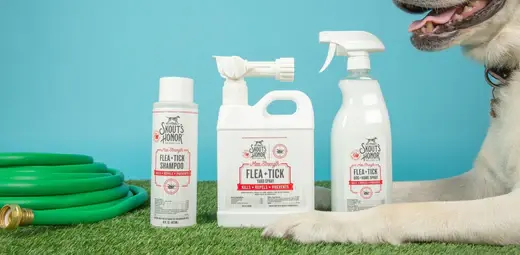How to Get Rid of Fleas on Dogs Naturally

As a dog owner, the sight of your pet scratching excessively can be alarming. Could it be fleas? Fleas are fast-breeding parasites that feed on your dog’s blood and lay dozens of eggs daily. Worse still, they don’t stay on your dog—they spread to your furniture, carpet, and even your lawn, making reinfestation a major concern.
If your dog has fleas, immediate action is crucial to prevent a full infestation. Here’s how to identify fleas, why natural remedies are effective, and tips for preventing fleas from making a comeback.
Signs Your Dog Has Fleas
While healthy dogs will scratch regularly, dogs with fleas will scratch excessively. So if you notice your dog repeatedly scratching or chewing on his skin, there’s a good chance he or she has fleas. Take a closer look to confirm your suspicions. Flea bites on your dog’s skin will be raised and red. If your dog has had fleas for a while, he or she may be missing patches of fur from excessive chewing or scratching. In some cases, they may even have scabs from repeatedly scratching the same areas.
What Do Fleas Look Like on Dogs?
As you look closely at your dog, keep an eye out for three things: fleas, flea eggs and flea dirt.
- Fleas are small, brown or reddish-brown bugs that you’ll find at the base of your dog’s fur strands. They tend to measure about 2.5 mm in length, and you’ll know what they are because they jump when disturbed.
- Fleas also leave behind a substance called flea dirt, which is flea feces made up of your dog’s blood. Flea dirt looks like tiny, black specks of sand, and it’s a telltale sign of fleas. Look for it in patches at the base of your dog’s tail, neck and armpits, as these are popular spots for fleas to hide.
- As you go, keep an eye out for flea eggs as well. You will have to eradicate both the fleas and their eggs to prevent future flea infestations. Flea eggs are tiny, white, rice-shaped specks. They are commonly mistaken for dandruff flakes. Naturally, if your dog has light-colored fur, it will be challenging to spot these minuscule eggs.
Use a flea comb (a small, fine-toothed comb designed to catch fleas and flea eggs) to inspect your dog’s fur carefully. Be sure to check your dog’s belly and armpits, as the fur is thinner in these areas and it will be easier to spot fleas.
Once you’ve confirmed your suspicions, it’s time to devise a flea treatment plan.
How To Treat Fleas Naturally
Fleas are commonly treated using medications or medicated baths designed to kill the fleas or make the dog an inhospitable environment for them to live in. While these methods are effective, they aren’t a good fit for all pets. Because most of these flea treatments contain drugs and chemicals, they can cause allergic reactions, skin irritation and other unpleasant side effects.
With this in mind, it’s preferable to treat fleas naturally. Fortunately, there are many natural remedies for both preventing and eradicating fleas. One excellent option for treating fleas holistically is the Skout’s Honor Flea and Tick Shampoo. This product is formulated with natural, pest-fighting ingredients to kill and prevent fleas and ticks and repel mosquitos.
The Flea and Tick Shampoo is a one-stop-shop for flea treatment. If you find that your dog has fleas, use the shampoo to kill them off. Then, use it every two weeks to prevent future infestations. It’s a simple and safe solution for flea and tick prevention.
Check out the Skout's Honor full line of flea and tick solutions here.
How Do Dogs Get Fleas?
In a perfect world, your dog would never have to experience the discomfort of a flea infestation. While there are no guarantees, understanding how dogs contract fleas can help you prevent your furry friend from coming into contact with them.
The most common way for dogs to get fleas is from other pets and grass. If your dog frequently visits a dog park, doggy daycare or anywhere else where he or she will be in close contact with other pets, the chance of contracting fleas is higher. Additionally, if your dog spends lots of time outdoors, he or she could pick up fleas from the grass. Fleas are present on many wild animals, such as squirrels, raccoons, bunnies and more. So each time your pup goes out to frolic in the grass, there’s a risk of bringing fleas back inside.
As you can see, a regular flea preventive regimen is essential.
Final Thoughts
There’s no question that a flea infestation is unpleasant for both you and your dog. Now that you know how to tell if your dog has fleas, you’ll be able to take action quickly to eradicate the fleas before they spread.
Be sure to regularly use the Skout’s Honor Flea and Tick Shampoo to keep these pesky parasites far from your precious pup.
Janine DeVault is a pet writer, animal rescue advocate and former celebrity dog walker. She has worked with a variety of pet industry clients and specializes in writing pet lifestyle content. Janine lives in Canada with her rescue cat, Kesi.



